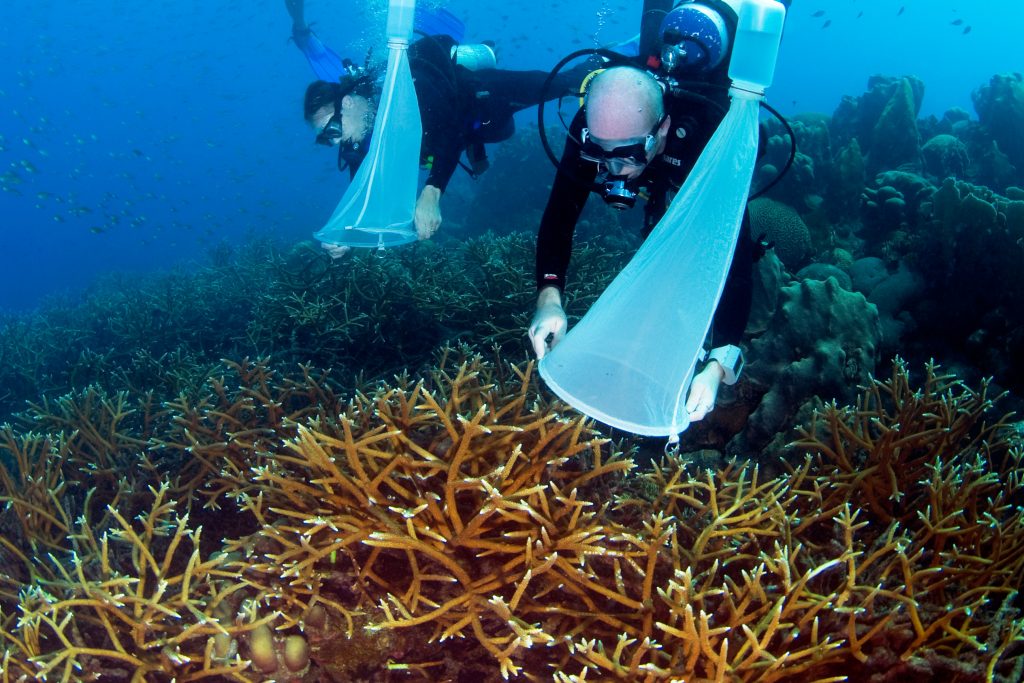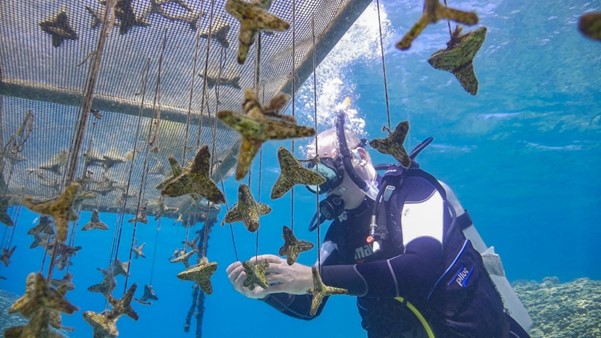Larval-based Coral Propagation
Successful reproduction and recruitment of new corals with diverse traits are essential for restoring coral populations. If coral populations are low, limited recruitment can significantly inhibit coral reef recovery even with other management actions in place. This section describes the steps involved with restoring coral populations through larval propagation methods utilizing the sexual reproduction process.
Although mass coral spawning occurs only a few times per year, these events can provide millions of baby corals — each of which represents a new genetic individual. The most important benefits of utilizing larval propagation for coral restoration is the ability to:
- Dramatically scale up restoration efforts by increasing the number of coral outplants
- Work with a diversity of coral species, including branching and boulder corals
- Increase the genetic diversity of corals on reefs, allowing them to adapt to changing environmental conditions

Collecting coral gametes from Acropora corals. Photo © Barry Brown/SECORE International
Steps of Larval Propagation
Collecting Spawn
Collecting spawn from the field is most appropriate for corals that reproduce through broadcast spawning. Thus, knowledge of local coral populations and their reproductive biology should be determined before collections begin. Identifying which coral species you will obtain larvae from prior to collections will help ensure higher success because it will allow you to determine the timing of mass spawning events.
Tips on predicting coral spawning can be found on the Caribbean Coral Spawning Webinar and prediction charts below developed by the Coral Restoration Consortium's Larval Propagation Working Group.
Fertilization
In the fertilization step, coral gametes collected from different parent colonies are combined and gently agitated to promote encounters. Coral gametes are viable for several hours after spawning occurs. Thus, it is critical that the fertilization phase of larval propagation occurs as soon as is feasible, where gametes from different parents are combined. In addition to timing, concentration of the gametes is another important factor to consider.
Watch the video from SECORE International: SECORE – When Sperm Meet Egg
Rearing Larvae
Early-stage embryos are visible approximately four hours after fertilization using a dissecting microscope. After a few days of development, coral embryos form free-swimming larvae. There are various methods that can be used to culture and rear coral larvae through the development phase until they are competent to settle. Any of these methods will be more successful if you begin with high fertilization rates. Generally, the strategy is to keep the larvae in an environment of appropriate temperature and water quality.
The rate of development, and hence the time until the larvae are ready to settle, will depend both on the coral species and on the temperature, as larvae develop faster with warmer water temperatures. Thus, regular monitoring is recommended during this phase.
Watch the video from SECORE International: SECORE Video – Coral Larvae Rearing Set-up at University of Guam
Settlement
After swimming in the open ocean environment, coral larvae need to find a suitable substrate on coral reefs to settle and undergo metamorphosis to become a primary polyp. Coral larvae use myriad complex cues including light, sound, surface texture, and chemicals to choose where on the reef they will settle and live.
For restoration using larval propagation, encouraging settlement of cultured larvae is commonly done in two ways: directly onto the reef or onto artificial substrates that will later be outplanted.
Outplanting Settled Corals
The end goal for newly settled corals is for them to contribute to the reef ecosystem and promote coral population recovery. This involves outplanting these new corals to a reef. If settled onto artificial substrates, outplanting is done after a short period of growth in a protected environment, such as a field-based or land-based nursery.
Watch the video from SECORE International: SECORE Video – Reseeding the Reef

Checking seeding units with coral recruits that have been kept in an ocean based nursery before outplanting. Photo © SECORE International/Reef Patrol

This content was developed with SECORE International. For more information, contact info@secore.org or visit their website at secore.org.
